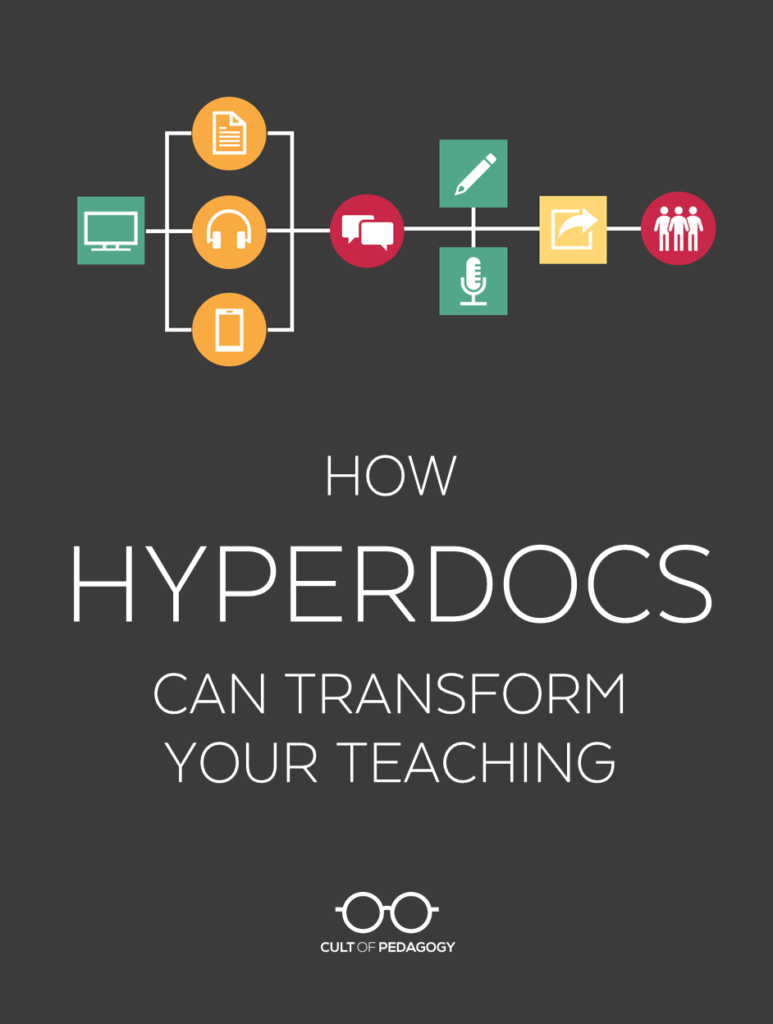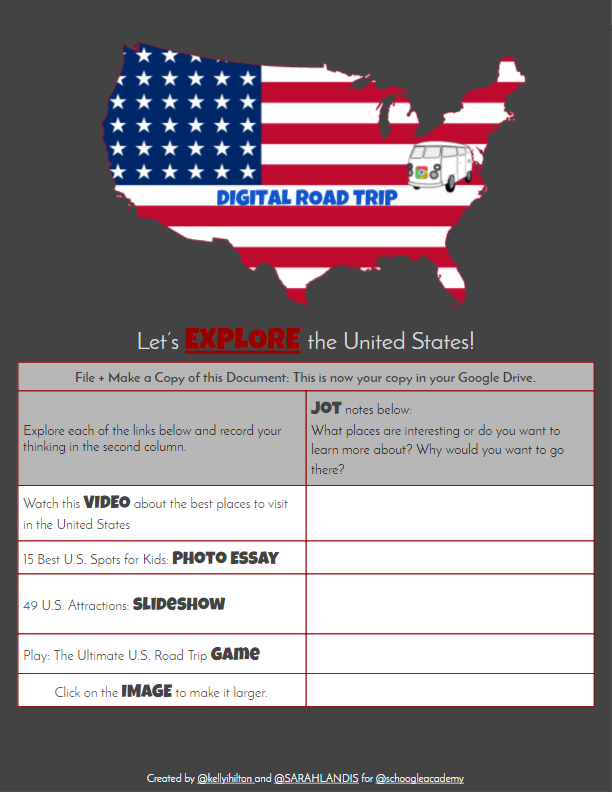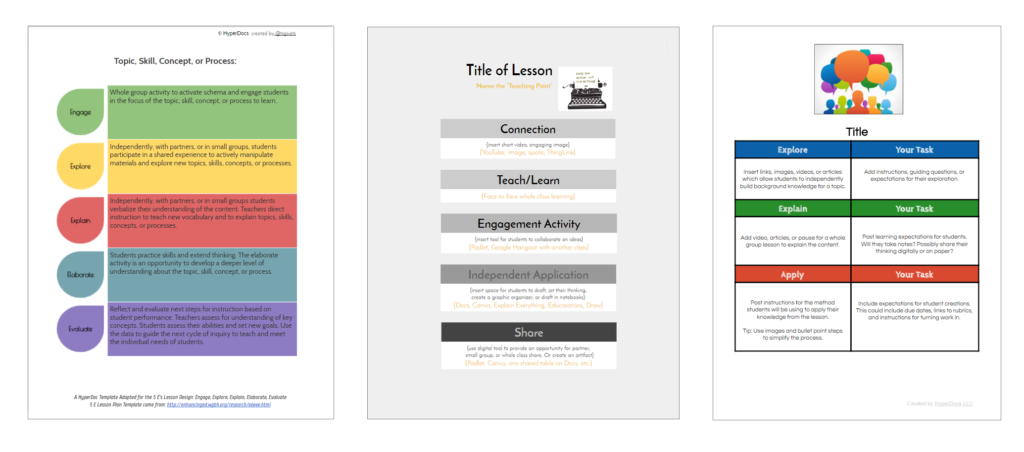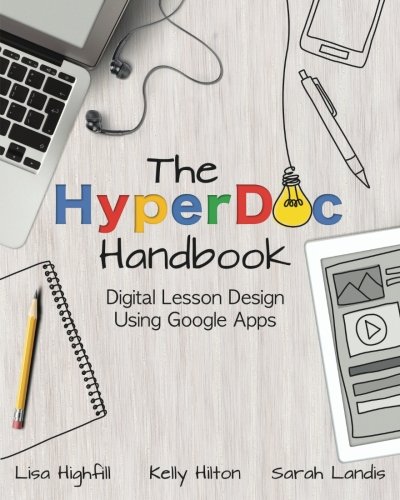How HyperDocs Can Transform Your Teaching

Listen to my interview with Lisa Highfill, Kelly Hilton, and Sarah Landis, authors of The HyperDoc Handbook (transcript):
In many classrooms, a learning cycle looks something like this: First, we write plans for a series of lessons and a final assessment. We gather materials—handouts, websites, rubrics, video clips. Then we teach the lessons one at a time, to the whole class, at the same pace, distributing materials as needed. Finally, we end with a project, test, or other assessment.
It’s a very teacher-directed model, which can limit learning in a number of ways:
- Students don’t feel much ownership for their own learning. Instead, they depend on the teacher to tell them when and how to learn the material.
- Because so much of the teacher’s time is spent in direct instruction, there’s little opportunity to work one-on-one with students.
- Because it’s up to the teacher to adjust instruction for students with varied needs and levels of readiness, differentiation becomes one more thing to do.
ENTER THE HYPERDOC
A HyperDoc is a digital document—such as a Google Doc—where all components of a learning cycle have been pulled together into one central hub. Within a single document, students are provided with hyperlinks to all of the resources they need to complete that learning cycle. Here’s an example.

This is page 1 of a 3-page HyperDoc. Click here to view the whole thing.
In the above HyperDoc, all of the bolded words are linked to outside resources. The right-hand column is set aside for students to take notes and do other kinds of thinking and planning as they work through the lesson.
One of the earliest iterations of the this type of “hub” was the WebQuest, which guided students through a lesson using all online resources. Now that Google tools like Docs and Slides have become so prevalent, teachers are using these tools to create similar lessons, choosing and mixing resources that go well beyond simple web pages. Last year, we looked at something called a playlist, which teacher Tracy Enos used to organize her language arts lessons and differentiate instruction for her students.
This post contains Amazon Affiliate links; if you purchase from Amazon after going through these links, Cult of Pedagogy receives a small commission at no extra cost to you.
Meanwhile, teachers Lisa Highfill, Kelly Hilton, and Sarah Landis were doing similar work in their own classrooms. They coined the term “HyperDoc” to describe their version of this, and in 2016, they published The HyperDoc Handbook to teach others their method for creating these lessons.

Kelly Hilton, Lisa Highfill, Sarah Landis
The book explains how HyperDocs work, why they have such an impact on instruction, and their model for how teachers can design HyperDocs for high-quality instruction. In the podcast episode above, I interviewed all three about their work. Here I will blend their expertise with some of my own thoughts about this exciting format.
BENEFITS OF HYPERDOCS
- Fewer lectures. Teachers have been told for decades that we need to do less lecturing, to step away from being the sage on the stage and become more of a guide on the side. “I feel so bad for teachers when they hear that,” Highfill says, “because they’re like, ‘Well, what am I supposed to do? I need to get information into their heads.'” A HyperDoc offers a solution by taking care of the direct instruction part of a lesson and offering a lot more as well.
- More face-to-face interaction. A good HyperDoc runs itself, allowing students to work through it without needing you to guide them through each step. “Although it seems odd that you’re putting a student in front of a device,” Landis notes, “really what it’s doing is freeing you up to move around and have increased face time with the students.”
- Flexibility. If one part of your lesson isn’t working, you can just change it in the HyperDoc and the change takes effect immediately; no need to re-copy all your materials. Similarly, if each student gets their own copy of a HyperDoc, the elements can be changed on each to meet individual students’ needs.
- Multimodal opportunities. Because it is digital, a HyperDoc allows us to include all kinds of multimedia. “Living in this digital age, we’re able to expose kids to different types of media that allows each child to access the learning or the content or the information in a way that’s visually or auditorily appealing to them,” Landis says. “I might be visual, and I might first study an image, then watch a video, and then I’m finally ready to tackle that article my teacher really wants me to read.”
- Privacy. If students’ HyperDocs have been customized for them, no one else needs to know. “They don’t know that maybe their text … is at a different reading level,” says Hilton. “Or they’re able to use Read&Write for Google and just put headphones in, and that’s just a little agreement between you and that student.”
MODELS FOR BUILDING HYPERDOCS
Because HyperDocs are such adaptable tools, teachers structure them in many different ways, and you should experiment until you find a structure that works for you. Here are some options to consider:
Playlist: This model, explained in this article, follows a step-by-step sequence of activities that consist of learning activities as well as check-ins with the teacher and housekeeping tasks like setting up accounts on websites.
Self-Paced Learning: Explored in this post by math teacher Natalie McCutchen, this system lays out a path of lessons for a whole unit, along with links to review materials, pre-tests, and practice questions. Students decide how much practice they need and determine when to take the assessment for each learning goal. If they grasp the material quickly, they can test and move on.
5E Model: This first stage of this model is to Engage student interest. Next, students Explore the topic, Explain what they have learned, and Extend their learning by applying it in new situations. The last stage Evaluates student learning.
HyperDoc Model: The HyperDoc Handbook authors have developed a model that has some components of the 5Es above, but with some additions and adjustments. This template explains all 7 stages. One important component of this model is the first step, Explore. Highfill explains the value of this stage: “Kids are exploring and coming up with ideas and answers about a concept on their own, and it’s engaging them from the beginning, instead of passively listening to a teacher explain something.” During this time, while students explore, the teacher is actively gathering information: “I listen to my students,” Highfill says, “I’m studying them and hearing to what level are they understanding a concept. I have the ability to pull a small group. I can work with my language learners during that time. The whole time I’m doing formative assessment in the classroom, which will then really be my basis for the next part of the lesson.”
Agenda: This model, borrowed from the kind of planning done at a typical Montessori school, provides each student with a planner listing out their assignments for the week. Students decide how they want to use their class time each day, but are expected to complete all goals by the end of the week. Although these are traditionally done on paper, they could easily be converted to a HyperDoc format.
OTHER USES FOR HYPERDOCS
Building an extended lesson or unit is one of the most instructionally robust ways to use HyperDocs, but they can also be used for:
- substitute teacher plans
- video or podcast playlists
- learning centers or stations
- student-made HyperDocs
- parent resources
- departmental-, team-or grade-level HyperDocs to gather and share resources among teachers
TIPS FOR SUCCESS
Start with a template.
Rather than build your first HyperDoc from scratch, you might find more success by starting with a pre-made template, like the ones available for free on HyperDocs.co. You could also start with a completely finished HyperDoc that someone else created for their own classroom and modify it for your own use.

A few samples of the templates teachers can copy for their own use on HyperDocs.co
Build in participation, collaboration, and multimedia.
One risk inherent in HyperDocs is that they could simply become online worksheets, replicating the kind of work students could just as easily do on paper. Take advantage of this medium by including ways for students to participate actively, collaborate with others, and learn from a variety of media: video, interactive posters like ThingLinks, podcasts, online flashcards, and so on.
Offer choice…
HyperDocs are designed to allow students to work at different speeds and navigate learning in a way that works best for them. So when you can, offer choices: Give students options for the kind and quantity of materials they need to learn the material, how they will practice and apply it, and how they will demonstrate their learning.
…but don’t “kitchen sink” it.
If you stuff your HyperDoc with every possible resource on a topic (“everything but the kitchen sink”), you’ll overwhelm students. Choose resources thoughtfully.
Give students HyperDocs training.
Even if your students have used HyperDocs in other classes, your design probably has its own unique qualities, so take the time to demonstrate how it should be used. And within the HyperDoc itself, provide clear directions for its use.
Collaborate with other teachers.
You do not need to do this alone! Thousands of teachers are sharing and collaborating on the HyperDocs.co site and using the #hyperdocs hashtag on Twitter. And be sure to give credit to the person who created the original: “So if you create a HyperDoc,” says Hilton, “in the header or footer, say Created by, and maybe link to your Twitter handle or your email, for yourself, and then if you make a copy of someone’s, we encourage you to give that person credit by saying Inspired by or Remixed HyperDoc originally created by, just because we want an inclusive, appreciative sharing community.”
Don’t feel like you have to create a HyperDoc for every lesson.
“That’s not something that any teacher should feel pressured to do,” says Landis, “and it’s not really realistic. We don’t want teachers doing any one thing all the time, because then it becomes redundant for our kids.”
HyperDocs Resources: How to Learn More
Book: The HyperDocs Handbook
Website: HyperDocs.co: The online hub for Landis, Hilton, and Highfill’s work on HyperDocs. It contains helpful blog posts and the Teachers Give Teachers system where participants share their own HyperDocs with one another. To browse and borrow other teachers’ HyperDocs, all you need to do is register.
Professional Development
Social Media
- Twitter (and check out the #hyperdoc and #hyperdocs hashtags as well!)
Join our mailing list and get weekly tips, tools, and inspiration—in quick, bite-sized packages—all geared toward making your teaching more effective and fun. You’ll get access to our members-only library of free downloads, including 20 Ways to Cut Your Grading Time in Half the e-booklet that has helped thousands of teachers save time on grading. Come on in!!
